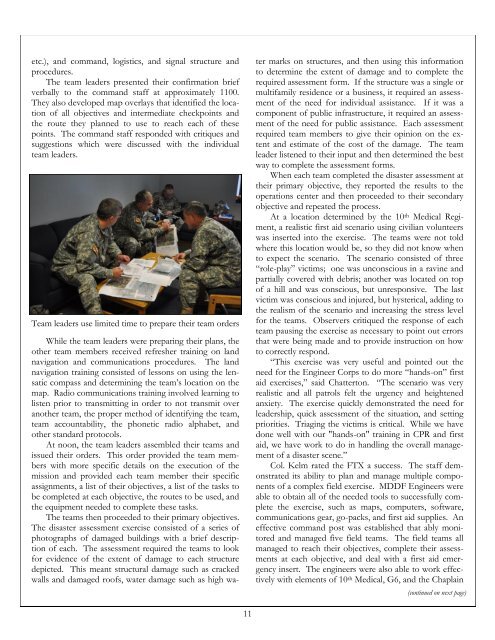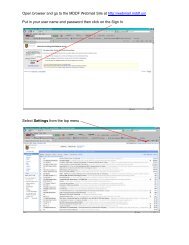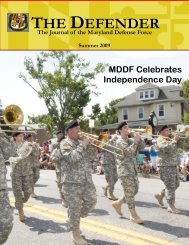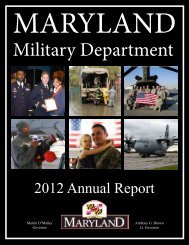The Defender, Winter 2009 - Maryland Defense Force - Maryland.gov
The Defender, Winter 2009 - Maryland Defense Force - Maryland.gov
The Defender, Winter 2009 - Maryland Defense Force - Maryland.gov
You also want an ePaper? Increase the reach of your titles
YUMPU automatically turns print PDFs into web optimized ePapers that Google loves.
etc.), and command, logistics, and signal structure and<br />
procedures.<br />
<strong>The</strong> team leaders presented their confirmation brief<br />
verbally to the command staff at approximately 1100.<br />
<strong>The</strong>y also developed map overlays that identified the location<br />
of all objectives and intermediate checkpoints and<br />
the route they planned to use to reach each of these<br />
points. <strong>The</strong> command staff responded with critiques and<br />
suggestions which were discussed with the individual<br />
team leaders.<br />
Team leaders use limited time to prepare their team orders<br />
While the team leaders were preparing their plans, the<br />
other team members received refresher training on land<br />
navigation and communications procedures. <strong>The</strong> land<br />
navigation training consisted of lessons on using the lensatic<br />
compass and determining the team’s location on the<br />
map. Radio communications training involved learning to<br />
listen prior to transmitting in order to not transmit over<br />
another team, the proper method of identifying the team,<br />
team accountability, the phonetic radio alphabet, and<br />
other standard protocols.<br />
At noon, the team leaders assembled their teams and<br />
issued their orders. This order provided the team members<br />
with more specific details on the execution of the<br />
mission and provided each team member their specific<br />
assignments, a list of their objectives, a list of the tasks to<br />
be completed at each objective, the routes to be used, and<br />
the equipment needed to complete these tasks.<br />
<strong>The</strong> teams then proceeded to their primary objectives.<br />
<strong>The</strong> disaster assessment exercise consisted of a series of<br />
photographs of damaged buildings with a brief description<br />
of each. <strong>The</strong> assessment required the teams to look<br />
for evidence of the extent of damage to each structure<br />
depicted. This meant structural damage such as cracked<br />
walls and damaged roofs, water damage such as high wa-<br />
11<br />
ter marks on structures, and then using this information<br />
to determine the extent of damage and to complete the<br />
required assessment form. If the structure was a single or<br />
multifamily residence or a business, it required an assessment<br />
of the need for individual assistance. If it was a<br />
component of public infrastructure, it required an assessment<br />
of the need for public assistance. Each assessment<br />
required team members to give their opinion on the extent<br />
and estimate of the cost of the damage. <strong>The</strong> team<br />
leader listened to their input and then determined the best<br />
way to complete the assessment forms.<br />
When each team completed the disaster assessment at<br />
their primary objective, they reported the results to the<br />
operations center and then proceeded to their secondary<br />
objective and repeated the process.<br />
At a location determined by the 10 th Medical Regiment,<br />
a realistic first aid scenario using civilian volunteers<br />
was inserted into the exercise. <strong>The</strong> teams were not told<br />
where this location would be, so they did not know when<br />
to expect the scenario. <strong>The</strong> scenario consisted of three<br />
“role-play” victims; one was unconscious in a ravine and<br />
partially covered with debris; another was located on top<br />
of a hill and was conscious, but unresponsive. <strong>The</strong> last<br />
victim was conscious and injured, but hysterical, adding to<br />
the realism of the scenario and increasing the stress level<br />
for the teams. Observers critiqued the response of each<br />
team pausing the exercise as necessary to point out errors<br />
that were being made and to provide instruction on how<br />
to correctly respond.<br />
“This exercise was very useful and pointed out the<br />
need for the Engineer Corps to do more “hands-on” first<br />
aid exercises,” said Chatterton. “<strong>The</strong> scenario was very<br />
realistic and all patrols felt the urgency and heightened<br />
anxiety. <strong>The</strong> exercise quickly demonstrated the need for<br />
leadership, quick assessment of the situation, and setting<br />
priorities. Triaging the victims is critical. While we have<br />
done well with our "hands-on" training in CPR and first<br />
aid, we have work to do in handling the overall management<br />
of a disaster scene.”<br />
Col. Kelm rated the FTX a success. <strong>The</strong> staff demonstrated<br />
its ability to plan and manage multiple components<br />
of a complex field exercise. MDDF Engineers were<br />
able to obtain all of the needed tools to successfully complete<br />
the exercise, such as maps, computers, software,<br />
communications gear, go-packs, and first aid supplies. An<br />
effective command post was established that ably monitored<br />
and managed five field teams. <strong>The</strong> field teams all<br />
managed to reach their objectives, complete their assessments<br />
at each objective, and deal with a first aid emergency<br />
insert. <strong>The</strong> engineers were also able to work effectively<br />
with elements of 10 th Medical, G6, and the Chaplain<br />
(continued on next page)






